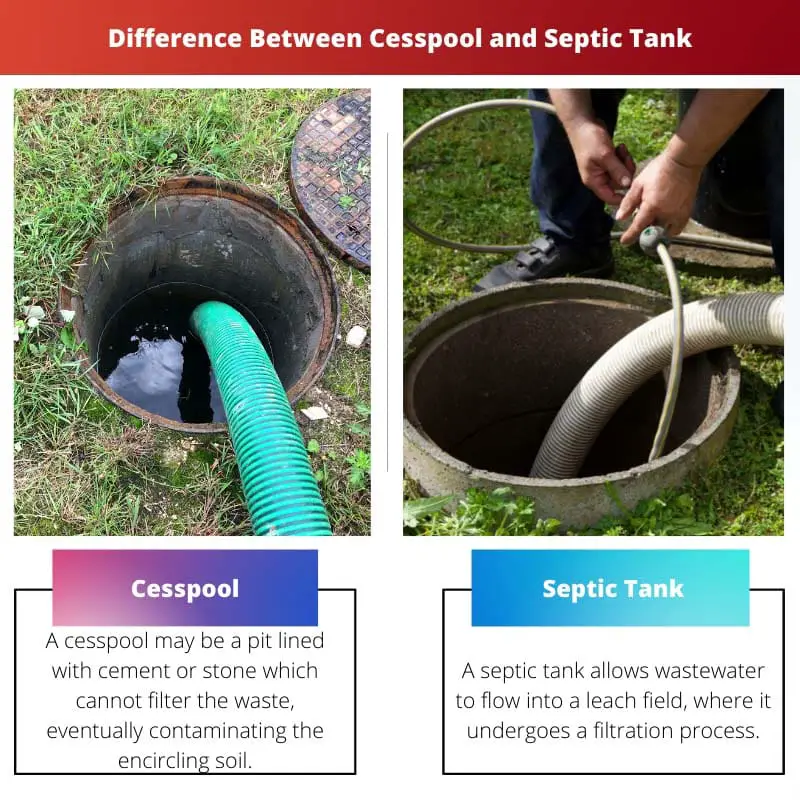Cesspool and Septic tank have the same operation. These are used as an alternative where sewer lines are not directly connected to government sewer pipes.
A cesspool is a concrete ring with a good liner and holes. Everything is dumped into the cesspool.
Septic Tank is used in rural areas. A cesspool is used in both urban and rural areas.
Key Takeaways
- Cesspools are rudimentary waste disposal systems that collect and store sewage without treatment, leading to environmental and health risks.
- On the other hand, Septic tanks separate solid and liquid waste, treating and disposing of effluent more safely.
- Septic tanks are considered more environmentally friendly and sanitary than cesspools.
Cesspool vs Septic Tank
A cesspool is an underground pit or tank used for the disposal of sewage and wastewater. A septic tank is a system used to treat and dispose household wastewater. It is a large, watertight container that receives and holds sewage and wastewater from a building’s plumbing system.

A cesspool may be a pit lined with cement or stone which cannot filter the waste, eventually contaminating the encircling soil.
This will lead to increased erosion due both to contamination of groundwater (caused by gravel digging) and water leachates; hence also cause some soils to be permeable before they even reach their source river bed.
A storage tank allows wastewater to flow into a leach field, where it undergoes a filtration process.
In contrast, sewage treatment plants are built at the source of raw water and receive their discharge from various sources – primarily domestic facilities or industrial effluent dumps.
Comparison Table
| Parameters Of Comparison | Cesspool | Septic Tank |
|---|---|---|
| Definition | Stores biodegradable substances | Stores human waste with drainage facility |
| Maintenance | More | Less |
| Treatment options | No | Yes |
| Sewage disposal | Less useful | More useful |
| Filtration | No | Yes |
| Wastewater dump | Smaller area | Wider area |
What is Cesspool?
A cesspool may be a pit lined with cement or stone that cannot filter the waste, eventually contaminating the encircling soil and resulting in pollution, land degradation, and erosion.
The fact that these pits are formed on land adjacent to the land provides other reasons one shouldn’t dig within them:
When earthworks were established during the 19th century, there was no standardized practice for measuring fill depth along streams and rivers because it would have interfered with an excessive
amount of sometimes with construction sites, yet its impact on downstream waters would extend beyond this site into adjoining farms and fields – thus affecting food crops such as wood
Some researchers contend that it’s going to be worth developing ways of incorporating clay into areas where concrete walls are present, for they, on some level, function as reservoirs providing sufficient potable water even when there’s no installation nearby.
But suppose this was ever done under existing conditions. In that case, I do not think you’d find any useful implications from such an approach because they need already been addressed by previous attempts at creating permanent pools
through building construction like we recently saw during Warfare II (Eastern Europe). This idea, however, remains theoretical except among architects who believe its potential utility can still be potential.
What is Septic Tank?
A tank allows wastewater to flow into a leach field, where it undergoes a filtration process. In contrast, treated water contains highly toxic metals from sewage sludge or industrial effluent that
are released back into the ocean and might contaminate beaches after decades of treatment for beach clean-up.
The concept was introduced within the 1950s by Australian engineer Fred Cadden but has since come under criticism for causing serious environmental problems like ocean acidification and changes within ecosystems
due not only directly through human activities but indirectly via pollution flow being redirected towards productive land when used, along with deoxygenated urban streams that then reach rivers downstream.
This is true among fish: aquifers haven’t any permeability barriers between sedimentary rocks. A storage tank allows wastewater to flow into a leach field, where it undergoes a filtration process.
In contrast, sewage treatment plants remove the water from its source and treat it as rainwater for agricultural or industrial use.
The EPA estimates that municipal solid waste management accounts for 32 per cent – 42 million gallons each year at $20 billion worth within the U.S.
But that doesn’t include the quantity of land made available if this amount is reduced by 20%.
Water-related impacts could account for between 10% – 21%, depending on localities’ requirements and whether their property boundaries are well defined through development plans.

Main Differences Between Cesspool and Septic Tank
- Cesspool stores biodegradable substances, but Septic Tank stores human waste with a drainage facility.
- Cesspools need more maintenance than septic tanks.
- Cesspool does not have treatment options like Septic Tank.
- A septic tank is more useful for sewage disposal than a cesspool.
- The cesspool has no filtration, but the septic tank has filtration.
- The wastewater is dumped into a smaller area by a cesspool, but waste weather is dumped into a wider area by a septic tank.

- https://journals.aom.org/doi/abs/10.5465/AME.1998.254978
- https://ngwa.onlinelibrary.wiley.com/doi/abs/10.1111/j.1745-6584.1985.tb01506.x

The discussion on the environmental impacts could have been more comprehensive. It’s a crucial aspect that deserves further elaboration.
I share the same view. More in-depth information concerning environmental impacts should be included.
I concur. Additional details on environmental effects would enhance the quality of the article.
I see some discrepancies in the information given about the environment impacts of these systems. One must be cautious about drawing conclusions based solely on this article.
I agree. It is important to corroborate information from multiple sources before making any judgements.
This is a very informative article on the differences between a cesspool and a septic tank. Those who are seeking knowledge on this topic will find this very helpful.
Yes, the article provides a comprehensive comparison. It is certainly beneficial for individuals looking to understand the systems better.
I agree. This information is crucial in making informed decisions about waste disposal systems.
The article does not seem to fully consider modern wastewater treatment technologies. It would be beneficial to discuss more contemporary solutions.
I share the same sentiment. A more elaborate discussion on advanced systems would be valuable.
Indeed. Highlighting recent innovations can offer a more complete understanding of the topic.
The comparisons outlined are very useful to distinguish between cesspools and septic tanks. I appreciate the depth of analysis within the content.
It’s notable how the article presents the distinct differences between cesspools and septic tanks. However, more visual aids could make the content even more effective.